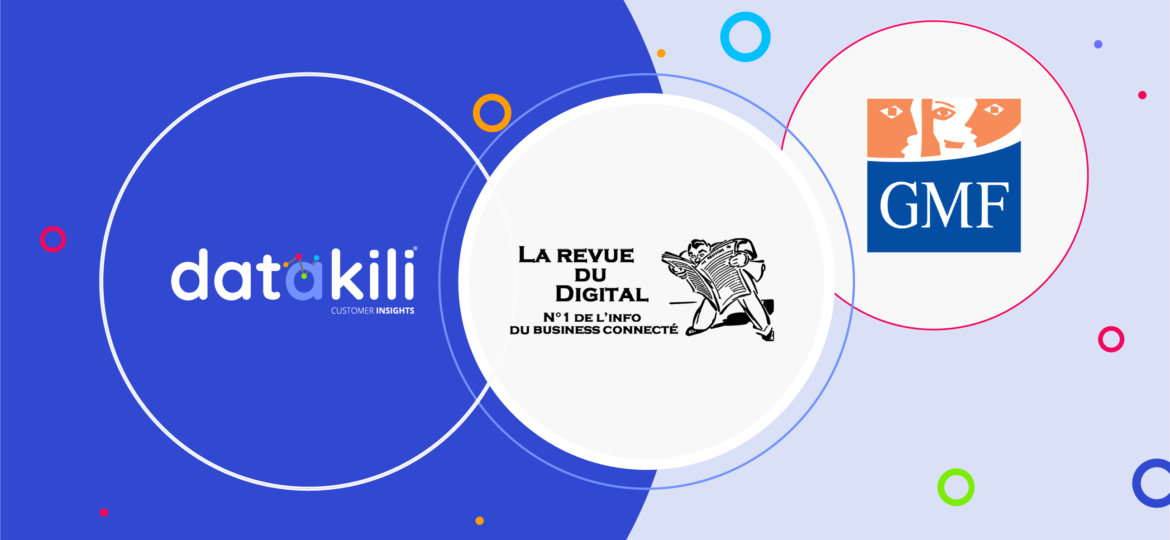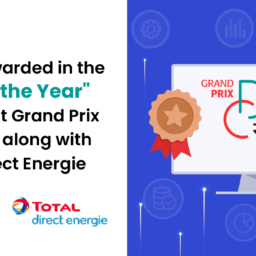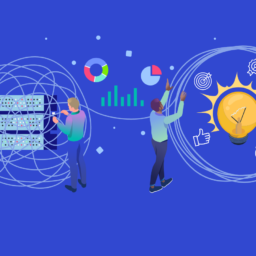
La Revue du Digital highlights GMF Assurances’ successful partnership with datakili
November 12, 2021
Insurance company GMF takes over its omnichannel customer journeys
In the digital age, prospect and customer journeys become more complicated than ever and keep evolving over time. The Covid-19 crisis is a striking example. The challenge for a company is to be able to map those customer journeys across all channels in order to increase sales while reducing churn.
A rational and scientific approach to analyzing all customer interactions
This is the task tackled by Florent Cueto, Head of Data and AI, in charge of customer knowledge, marketing automation, and Data and AI studies at GMF (Garantie Mutuelle des Fonctionnaires, COVEA Group). GMF is the leading insurer for civil servants in France with 3.5 million customers. The manager spoke at the Big Data & AI exhibition in Paris on September 28th and 29th.
A very rational and scientific approach has been conducted. It consists of collecting and centralizing all the interactions that customers may have with GMF in a hub – the interaction hub – to analyze them. Before, those interactions were stored in several data silos. Then, the omnichannel customer journey analytics solution delivered by the company Datakili has been chosen and implemented.
“We have analyzed a lot of customer journeys and we will keep on doing it. This is a fundamental task. Days of analytics work now only take 2 hours since the solution has been implemented, this is the fastest way to analyze many journeys”. says Florent Cueto. Thanks to the platform, the insurer’s Data team obtained valuable insights on GMF’s commercial follow-up processes. Sales and customer retention gains are also subject of various analysis.
At first, GMF had decided to develop an in-house solution. Five data specialists from the Data team had mapped all the purchase journeys for Vehicle and Home insurance. It took almost 6 months to succeed in this job. “It taught us that customer journey mapping is really useful and actionable. It was really an activity that we needed to do. And we also saw that this was very complex to achieve and very time consuming. If we wanted to map all our journeys across all our products, with the team I had, that was not possible” comments Florent Cueto. “With datakili, we have reduced the data scientist team dedicated to this task by 3.” Datakili is capable of carrying out such mapping automatically in an omni-channel environment which combines the digital channels, the call center and GMF’s offices.
A database that contains 100 million interactions
The database is based on two and a half years of data, 100 million customer interactions across 11 contact channels (mail, email, telephone, etc.) and 89 types of contacts with the customer. Data originates from Google Analytics for digital channels, Genesys datamart for phone calls, and GMF’s CRM for offline interactions.
The following parameters were chosen : the identification of the customer, the GMF employee concerned by the interaction (at the contact center, at the claims management center, etc.), the reason for the interaction with the customer (quote, change of address, etc.), the interaction channel (telephone, digital, office, etc.) and finally, the time stamp (day and precise time). The solution has been implemented and tested for a few months, then GMF decided to extend datakili use to the whole company business challenges.
“The solution is now in production. We knew we had to measure customer journeys. It was not an option” he says. The gains in terms of winning new contracts and decreasing churn is now being measured with omnichannel metrics.
A lot of different business cases managed
The unification and the analysis of all this data give GMF Data teams insights about the interactions’ quality. For example, the team assessed the impact of a quick follow-up call to customers after they requested a quotation for a vehicle insurance policy across digital channels. One year of results were analyzed. The figures show that insurance policy purchases raise by 2.5 points when there is a quick follow-up call. “We were able to see if quick follow-ups had an impact,” comments Jean Christophe Farkas, in charge of driving, reporting and measuring customer journeys at GMF. We also note that few follow-up calls succeed, because only 13% of them eventually reach the customer.
Another analysis on the same data confirmed that the ideal time frame for a follow-up call is 3 minutes after customers have completed their quote on the website. This is the time frame adopted by GMF and the conversion rate goes up to 24.3%. This is the highest observed rate. Otherwise, this rate ranges from 18.3% to 21.8%, when the next follow-up call exceeds 20 minutes.
Activate a customer follow-up process via the CRM
In another scenario, the Data team analyzed a customer journey featuring an online claim, followed by a phone call, and an immediate survey. Journeys with low satisfaction scores (less than 4 out of 10) were selected. “We know that customers who enter this sequence have a high risk of terminating. We aim to avoid termination, and we want to know what happened to improve the process” indicates Jean Christophe Farkas.
These customers can be integrated into GMF’s CRM to trigger a follow-up automation, whether via the call center, mailing or an office sales representative. The goal is to limit the churn rate and identify the pain points in the customer journey to decrease terminations. The solution features an algorithm which ranks, for example, the sequences of interactions that most likely lead customers to either a purchase, a claim or a termination. This should make it possible to focus on the interactions that deserve more attention. For example, to limit customer claims, GMF might need to modify digital content, or to review the sales representatives’ speech at the call center level.
React quickly if customers are about to terminate their contract with GMF
The other objective is to react quickly if a client enters into a termination process with GMF: “For example, during a 4-step termination process, we may be able to get in touch with customers at the 3rd step and prevent them from churning.” This is a massive project. At the same time, the question is about knowing what are the winning journeys that lead to the purchase of an insurance contract; what is the real contribution of the digital channels to purchases occurring in stores or over the phone; what are the impacts of communication actions, and marketing/advertising campaigns on customer journeys; which journeys generate a large number of calls to contact centers and which loyalty-building sequences can reduce churn.
The use of the solution will be widened to GMF’s business departments
The solution was first adopted by the Data team, then the objective is to make the platform available to all GMF’s business departments, that is to say compensation, distribution, marketing, digital, etc. There is a customer experience team at GMF, a customer experience team at Covea (GMF’s parent company), and the management of customer relationship is shared between different departments at GMF. “Hence the idea of giving access to the solution to all teams that deal with customer relationship subjects at a given time, so that they can optimize their own processes.” proposes Florent Cueto.
In addition, the interaction hub that has been set up will be enhanced for other uses. It will help enrich the 360° customer view as the current situation does not enable GMF to know everything its customers have done. This data will also be used to improve customer scores and audience segmentation to better target customers during marketing operations. Concretely, the project gathers all the data generated by the interactions with customers. “This is all about identifying the main journeys that customers go through to handle their life with their insurer” specifies the manager. To begin with, the first mapped journeys are the purchase journeys for both vehicle and home insurance policies.
The aim is to understand the main journeys that ends up in a purchase. “It is important to identify the significant purchase or termination journeys. But also the evolution of these customer journeys over time, under regulatory measures, changes in customer expectations or in a health crisis context” he continues. The second thing he is trying to detect are the pain points. “If 90% of the people who request a quote on the website give up or call the contact center, there may be a problem with the quote’s digital journey” he illustrates.
The next steps of the project will consist in enriching the interaction hub to break down GMF’s remaining data silos. In 2022, new interactions will be integrated for both assistance and financial recovery when customers are late in paying their bill.









